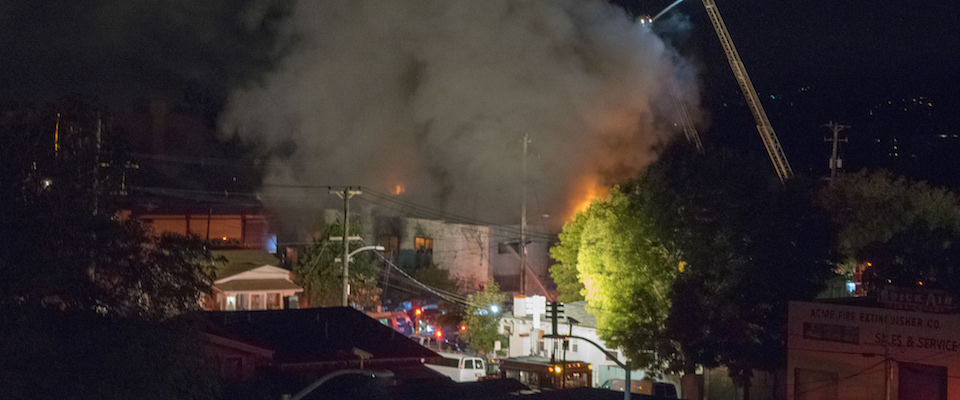The pain hasn’t subsided. For many people, it never will. Some traumas are simply too great to overcome, and there can be no true healing—only a bleak and comfortless accommodation.
But even as the personal suffering of survivors, and the family and friends of the dead, remain, enough time has passed since the Ghost Ship fire for civic reaction. And so far, the responses seem focused on removing artists and other low-income citizens from the substandard structures that house them. Several East Bay tenants living in “DIY” warehouses similar to the Ghost Ship have received eviction notices, and there is wide concern in the Bay Area artist community that this is just the leading edge of a broad trend, one that will leave large numbers of highly creative, accomplished, hard-working, if relatively poor, people out on the streets.
From one perspective, such moves are justified. Allowing large numbers of people to live in buildings that can’t meet even the most minimal construction and safety codes is simply begging a reprise of the Ghost Ship fire. But while mass evictions may reduce landlord and municipal liability, they do nothing to address the root problem: The lack of affordable housing in the Bay Area.
“The needs of artists may be unique, in that they need spaces for both creating and living, but the problem extends well beyond the artist community,” says Sara Hinkley, a Berkeley lecturer in City and Regional Planning and the associate director of the university’s Institute for Research on Labor and Employment. “Shortages of housing and community space are affecting everyone in the Bay Area who isn’t earning a professional salary. If artists can’t survive in a city, the same will be true for a lot of other people—waiters, child and elder care providers, cooks, retail workers—all the people a city needs to function.”
While the affordable space crunch may seem particularly dire in the Bay Area, it’s actually a global issue, observes Hinkley.
“The problem exists in urban areas around the world, and it’s addressed in ways similar to what we’ve seen in Oakland,” she says. “When there isn’t sufficient [built-to-code] space to live and work, needful people will create their own informal structures. Is it dangerous? Do disasters happen? Yes, but the streets are very dangerous too. In informal and unsanctioned spaces, people at least are comforted by the fact that they’re sheltered by walls and a roof, that they’re protected from the elements and the hazards of the street.”

Developer Bill Falik, who is a lecturer at Berkeley Law and an adjunct professor of real estate at the Haas School of Business, concurs with Hinkley, maintaining that a country as rich and powerful as the United States should find the means to ensure that the basic needs of its citizens are met.
“There are ways to turn this around, but they’re difficult to implement,” said Falik. “The lack of an adequate housing supply drives demand, and demand drives prices up. Unless we expand the housing supply or provide the means, such as subsidies, that allow lower income people to get into the market, we’re going to be dealing with these crises.”
The recent fire may have galvanized public attention to the lack of housing and work space for local artists, but Falik has been dealing with the issue for a long time. He has been on the board of the Berkeley Repertory Theatrefor about a decade, and has served as chairman of the organization’s facilities committee, tasked with helping the Rep’s cast and support staff find affordable housing.
“It’s been enormously challenging,” he says. “Many of our artists have been forced to drive substantial distances, or live in substandard circumstances. That’s not acceptable, so we’re looking to build a facility next to the theater to house artists and interns who can’t afford rents.”
Unfortunately, says Falik, the costs of land, financing and construction are rising so rapidly in the Bay Area that it has been difficult to get the project off the ground.
“In the last five years, costs have increased dramatically,” he says. “We’re working with the city and our donors to find a way, and it’s presenting us with some very hard choices, such as thinking about reducing the size of the facility or cutting back on amenities that we don’t absolutely need. We’re really scratching with our pencils, trying to figure this out.”
Falik says that many of the problems bedeviling affordable housing advocates are rooted in Proposition 13, the 1978 initiative that limited property tax rates. Since Proposition 13’s passage, says Falik, “public infrastructure”—not just basic housing, but schools, roads, police and fire departments, and even affordable health care—has declined because there isn’t a sufficient tax base to provide funding.
“Attempts are made to redress this at the state level, usually in the form of substantial bond measures,” Falik says, “but they have to comply with the constraints of Proposition 13, and that means they can be very difficult to pass.”
Hinkley emphasizes that low-income people in general, and perhaps artists in particular, need safe work and community spaces as well as secure housing.
“These are related but not identical issues,” she says. “Creating these community spaces can significantly improve the lives of low-income people even if they face ongoing housing difficulties. And cities can do a lot toward that end. San Francisco, for example, has made some effort to provide ‘art’ spaces. It gives artists a place to work and confer and build community solidarity. And both San Francisco and New York have built hybrid live-work spaces for artists that are up-to-code and safe.”
That takes money, of course, and Hinkley suggests that cities, especially fairly flush cities, such as those that ring San Francisco Bay, should do the right thing and make the requisite funding commitments.
“…[young artists] are here for a reason, and our cultural fabric would be substantially diminished if they moved to outlying areas.”
“Cities can require low-income housing components for new market rate developments, or they can levy fees on developers who don’t include such housing and use the money to construct affordable units and community spaces,” she says. “Cities can also assign fees to planning approvals and zoning variances, and apply those for artist and other low-income resident needs.”
Cities should also view existing warehouses and similar buildings with an eye toward renovation, says Hinkley. Many might be brought up to code, provide affordable live/work spaces, and still turn a profit for landlords.
“I think that’s a conversation worth having,” she says. “Many landlords are already making substantial profits on these buildings, including the ones that aren’t currently up to code. Plus, they have tremendous equity in them. Cities could work with landlords, or pressure them if necessary, to get them to redeem their properties for affordable living and working spaces.”
For free market purists, the solution to the artists’ dilemma is simple: Move out of the Bay Area. Go to San Bernardino, or Fresno, or Redding, or any of the myriad communities in California where rents are affordable. Be a pioneer. Rather than lament the financial pressures facing artists, establish new art communities in the low-rent hinterlands.
But while that may work for some artists, and landlords with properties in less developed and more affordable areas, it’d be a raw deal for the Bay Area, according to Falik and Hinkley.
“Along with teaching at Cal, I’m a developer in the Sacramento area, and I’d be delighted if a lot of Bay Area artists moved to, say, Roseville,” said Falik. “But if you’re a young artist, would you want to live in the Sacramento Valley or Berkeley, Oakland or San Francisco? They’re here for a reason, and our cultural fabric would be substantially diminished if they moved to outlying areas.”
Hinkley observes that an artist exodus from the Bay Area would deprive the region of its most important demographic asset: the young.
“Virtually everyone who died in the Ghost Ship fire was young, and that fact compounded the tragedy enormously,” she says. “It also says a great deal about the make-up of our artistic community. Most of them are in their twenties and early thirties. What happens to a place when no one in their twenties can afford to live there? I’ve talked to people in local city governments, and they’re extremely worried about this. They haven’t figured out how to move the needle, but they know they’re facing an enormous problem. You can’t continue to thrive as an economic and creative hub if all the young and innovative people move away, and all you’re left with are older people committed to making money.”






















